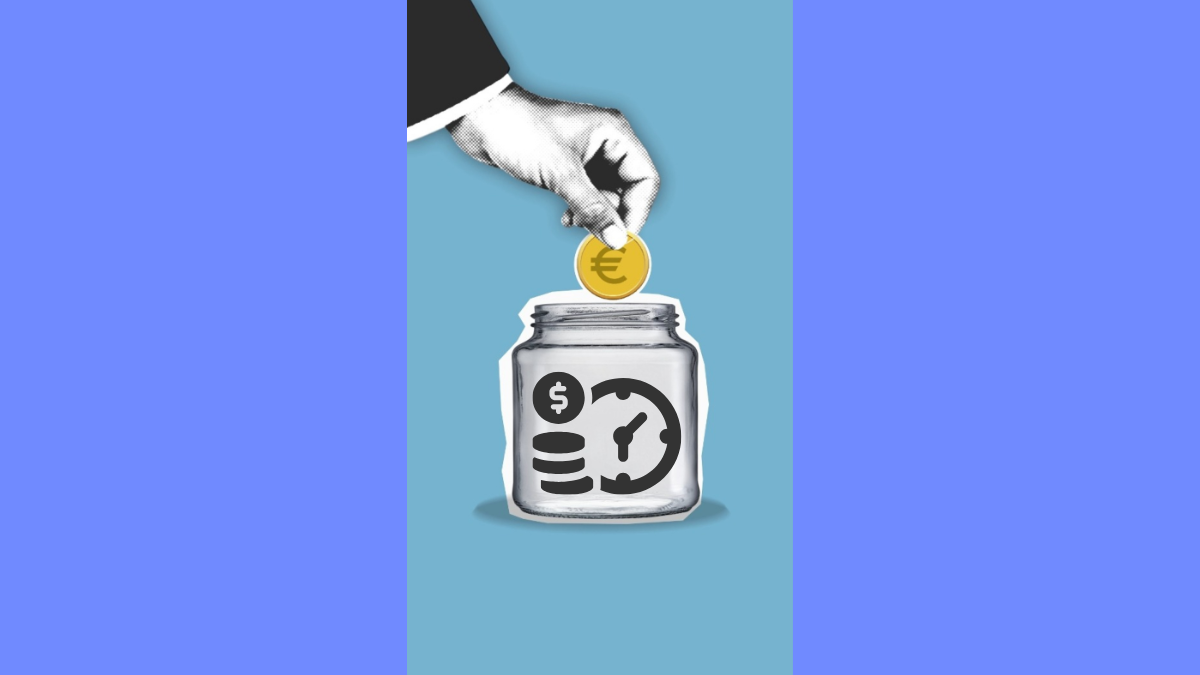What’s the Difference Between Short-Term and Long-Term Investing?
At its core, the difference between short-term and long-term investing lies in how long you plan to hold an asset — but the implications go far beyond just time.
 Short-term investing typically means holding investments for less than three years. This approach is often used to pursue quicker gains or to meet upcoming financial needs, like saving for a down payment or building a buffer for unexpected expenses. These strategies often align with financial goals such as automating savings or canceling unused subscriptions to free up cash that can be quickly reinvested.
Short-term investing typically means holding investments for less than three years. This approach is often used to pursue quicker gains or to meet upcoming financial needs, like saving for a down payment or building a buffer for unexpected expenses. These strategies often align with financial goals such as automating savings or canceling unused subscriptions to free up cash that can be quickly reinvested.
Long-term investing usually involves a horizon of three years or more, often spanning decades. It emphasizes patience and the power of compounding . A long-term investor may ride out market ups and downs — like staying invested during a downturn — with confidence that time will smooth out the volatility.
There’s also a tax implication: in the U.S., short-term capital gains are taxed at your regular income rate, while long-term capital gains (for investments held over a year) often receive more favorable treatment. That’s one reason why investors building toward goals like retirement, buying a home, or financial independence tend to lean long-term.
Quick Breakdown:
| Type | Time Horizon | Typical Goal | Common Assets |
|---|---|---|---|
| Short-Term | 0–3 years | Quick returns or liquidity | High-yield savings, short-term bonds, CDs, stocks |
| Long-Term | 3+ years | Retirement, wealth building | Index funds, ETFs, stocks, real estate |
Whether you lean toward short-term moves or take a patient long-term approach, it’s important to match your investment timeline with your risk tolerance, cash flow, and financial objectives. You’ll learn more about this in our guide on how to assess your risk level and choose assets accordingly.
Key Benefits and Drawbacks of Each Strategy
When comparing short-term vs. long-term investing, it’s not about which one is better — it’s about which is better for you. The right strategy depends on your financial goals, timeline, and risk profile. Let’s break down the benefits and drawbacks of both, from fast cash needs to long-term wealth-building. Short-Term Investing

Benefits:
- 1. Faster Access to Your Money
- 2. Flexibility to Respond to Market Opportunities
- 3. Useful for Short-Term Goals
- 4. Can Compliment Cash Flow Management
Drawbacks:
- 1. Higher Volatility and Risk in Short Timeframes
- 2. Tax Disadvantages
- 3. Requires Constant Attention
- 4. Emotional Decision-Making
Long-Term Investing
Benefits:
- 1. The Power of Compound Growth
- 2. Reduced Impact of Short-Term Volatility
- 3. Tax Efficiency
- 4. Lower Maintenance
- 5. Ideal for Retirement and Major Milestones
Drawbacks:
- 1. Lack of Liquidity
- 2. Delayed Gratification
- 3. Requires Patience Through Downturns
- 4. Over-Reliance on Projections
| Scenario | Short-Term Strategy | Long-Term Strategy |
|---|---|---|
| Goal: Buy a car in 12 months | High-yield savings, short-term CDs | Not ideal — funds could lose value |
| Goal: Retire in 30 years | Too risky or volatile for long horizon | Ideal — stocks, ETFs, index funds compound over time |
| Goal: Build wealth while working full-time | Hard to manage actively | Fits passive, consistent investing like ETFs or target-date funds |
Risk Profiles: Volatility, Time, and Liquidity
Understanding investment risk isn’t just about how much you could lose — it’s about how much time you have to recover, how liquid your assets are, and how comfortable you are with price swings. Different strategies come with different levels of volatility, time sensitivity, and accessibility.
Volatility: How Much Can the Value Swing?
Short-term investments tend to face higher volatility — especially if you’re investing in individual stocks or cryptocurrencies. Market news, interest rate changes, and even social media trends can shift prices dramatically overnight.
Example: If you bought a tech stock on Monday and there’s a disappointing earnings report on Thursday, your investment might drop 15% in a day.
This makes short-term investing inherently riskier, unless you’re using low-volatility assets like short-term bonds or CDs.
Long-term investments, on the other hand, can also face short-term dips — but they tend to recover and grow over time. This is why holding a diversified portfolio for 10+ years usually smooths out volatility. We explore this further in our post on how diversification reduces investment risk.
Historically, the S&P 500 has had negative returns in 1 out of every 4 years — but over any 20-year period, it’s almost always produced a positive average annual return.
Time Horizon: How Long Are You Willing to Wait?Your time horizon directly affects the type of risk you can handle.
- Short-term horizon (0–3 years): You can’t afford to wait for markets to recover, so riskier assets are a gamble. That’s why many use high-yield savings accounts or money market funds instead.
- Long-term horizon (10+ years): You have time to ride out recessions, crashes, and inflation cycles. This makes it easier to stay invested and benefit from compound growth.
Liquidity: How Easily Can You Access Your Money?
Liquidity refers to how quickly and easily you can convert an investment into cash without losing value.
- High liquidity: Savings accounts, money market funds, Treasury bills — perfect for short-term needs.
- Moderate liquidity: Stocks and ETFs — can usually be sold quickly but prices may fluctuate.
- Low liquidity: Real estate, retirement accounts (like 401(k)s), and some bonds — harder to access quickly or come with penalties.
Long-term strategies often accept illiquidity in exchange for higher returns. Real estate, index funds, and retirement accounts are common tools here. Some even invest in tax-advantaged accounts like Roth IRAs for additional growth potential.
| Factor | Short-Term Investing | Long-Term Investing |
|---|---|---|
| Volatility | High (frequent swings) | Lower over time |
| Time Horizon | 0–3 years | 3–40+ years |
| Liquidity | High (easy access) | Low to moderate |
| Risk Type | Timing risk, market timing | Market cycle risk, patience |
| Stress Level | Higher (requires attention) | Lower (requires discipline) |
Common Types of Short-Term Investments
Short-term investing is all about preserving capital while earning a modest return — all without locking your money away for too long. Whether you’re saving for a vacation, emergency fund, or big purchase within 1–3 years, these are the most widely used short-term investment options.
High-Yield Savings Accounts
These accounts offer higher interest rates than traditional banks, often around 4–5% as of 2025. They’re federally insured (FDIC) and allow you to access your money anytime.
- Pros: Safe, highly liquid, great for emergency funds
- Cons: Returns may not beat inflation
- Use When: You need instant access and zero risk
Certificates of Deposit (CDs)
CDs are fixed-term savings products offered by banks and credit unions. You lock your money for a set time — typically 6 months to 2 years — in exchange for a guaranteed interest rate.
- Pros: Predictable return, FDIC-insured, higher yield than savings
- Cons: Penalties for early withdrawal
- Use When: You won’t need the money before the term ends
Treasury Bills (T-Bills)
Issued by the U.S. government, T-Bills are low-risk and mature in 4, 13, 26, or 52 weeks. You buy them at a discount and get the full face value at maturity.
- Pros: Backed by the U.S. government, highly secure
- Cons: Slightly lower yield than riskier assets
- Use When: You want maximum safety with a short lock-up period
Money Market Funds
Not to be confused with money market accounts, these are mutual funds that invest in short-term debt (like T-bills and commercial paper). They aim to keep the share price stable while earning modest income.
- Pros: Better yield than savings accounts, relatively safe
- Cons: Not FDIC insured
- Use When: You want slightly higher yield and quick access
Short-Term Bond Funds
These funds hold bonds that mature in 1–3 years. They’re more volatile than savings accounts but often offer better returns.
- Pros: Higher income potential, professional management
- Cons: Prices can drop if interest rates rise
- Use When: You can tolerate a little risk for better returns
Brokerage Account with ETFs
Using a brokerage account, you can buy short-term bond ETFs, dividend-focused stocks, or even cash-like instruments. This is a more DIY approach that offers flexibility — but also more risk.
- Pros: Customizable portfolio, easy to rebalance
- Cons: Higher volatility, may require monitoring
- Use When: You want to actively manage short-term investments
Stablecoins (Advanced Option)
| Investment Type | Risk Level | Liquidity | Typical Return | FDIC Insured? |
|---|---|---|---|---|
| High-Yield Savings | Very Low | High | 4–5% | Yes |
| CDs (6–24 months) | Very Low | Low | 4.5–5.5% | Yes |
| Treasury Bills | Very Low | Low | 4–5% | No (but U.S. backed) |
| Money Market Funds | Low | High | 3–4% | No |
| Short-Term Bond Funds | Moderate | Medium | 4–6% | No |
| ETFs (DIY) | Varies | High | Varies | No |
| Stablecoins (Advanced) | High | Medium | 4–8% | No |
Common Long-Term Investment Options
Long-term investing is about growing wealth over years — even decades. The goal is to allow your investments to ride out short-term market swings and benefit from compound growth, tax advantages, and asset appreciation.
Whether you’re investing for retirement, a future home, or long-term financial independence, these are the most common tools used by successful long-term investors.

Index Funds (S&P 500, Total Market)
An index fund is a passive investment that tracks a specific market index, like the S&P 500 or total U.S. stock market. These funds are popular for long-term investors due to their low fees, broad diversification, and steady performance over time.
- Pros: Low cost, automatic diversification, historically strong returns
- Cons: Still subject to market downturns
- Use When: You want to build long-term wealth with minimal management
Exchange-Traded Funds (ETFs)
ETFs are similar to index funds but trade like stocks. Many long-term investors build portfolios using ETFs because they’re flexible and can be customized to target specific sectors (tech, clean energy, international, etc.).
- Pros: Lower cost than mutual funds, tradable during the day, broad variety
- Cons: Some are complex and not all are ideal for long-term holding
- Use When: You want diversification with more control than traditional mutual funds
Real Estate
Real estate is a classic long-term investment that can produce both rental income and property appreciation. It’s less liquid than stocks, but it adds diversification and often moves differently from the market.
- Pros: Passive income, hedge against inflation, tax benefits
- Cons: High upfront cost, ongoing maintenance, less liquid
- Use When: You’re prepared for active ownership or plan to hold for 10+ years
Retirement Accounts (401(k), IRA, Roth IRA)
These tax-advantaged accounts are specifically designed for long-term investing. They encourage consistent contributions and reward you with either tax-deferred (401k, traditional IRA) or tax-free growth (Roth IRA).
- Pros: Huge tax advantages, often includes employer match, automatic growth
- Cons: Early withdrawal penalties, contribution limits
- Use When: You’re investing for retirement and want to reduce your tax burden
Individual Stocks (Long-Term Positions)
While picking individual stocks requires more research and risk tolerance, long-term investors often choose high-quality companies they believe will grow over time. Think of companies like Apple, Google, or Coca-Cola held for 10+ years.
- Pros: Higher upside potential, can beat the market
- Cons: Requires more research, higher risk, not diversified
- Use When: You’re confident in your picks and willing to hold through ups and downs
Diversified Mutual Funds
Mutual funds pool money from many investors and are managed by professionals. While more expensive than ETFs or index funds, they can be useful for those who prefer hands-off management with automatic rebalancing.
- Pros: Professional management, diversification
- Cons: Higher fees, less flexible than ETFs
- Use When: You want simplicity and don’t mind slightly higher costs
Dollar-Cost Averaging (DCA) Strategy
This isn’t an asset — it’s a long-term investing method. By consistently investing a fixed amount (monthly or bi-weekly), you smooth out market volatility and reduce emotional decision-making.
- Pros: Reduces timing risk, builds habit, works well with automated investing
- Cons: Doesn’t protect from losses — just reduces entry risk
- Use When: You want a stress-free way to build a long-term portfolio
| Investment Type | Risk Level | Liquidity | Tax Advantages | Best For |
|---|---|---|---|---|
| Index Funds | Moderate | Medium | ❌ / ✅ in IRA | Passive wealth growth |
| ETFs | Moderate | High | ❌ / ✅ in IRA | Custom long-term portfolios |
| Real Estate | Moderate | Low | ✅ | Rental income + appreciation |
| Retirement Accounts | Low–High | Low | ✅ Huge | Retirement planning |
| Individual Stocks | High | High | ❌ / ✅ in IRA | High-growth investors |
| Mutual Funds | Moderate | Medium | ✅ in 401(k) | Hands-off investors |
| DCA Strategy | Varies | N/A | N/A | Long-term consistency |
When to Use Short-Term vs. Long-Term Strategies
Choosing between short-term and long-term investing isn’t about picking one forever — it’s about aligning your strategy with your timeline, goals, and cash needs. Here’s how to decide when to go short, long, or both.
Goal Type Strategy Why It Works
| Goal | Investment Type | Why |
|---|---|---|
| Emergency fund (3–6 months) | Short-Term | Needs liquidity and no risk |
| Vacation or big purchase (1–2 yrs) | Short-Term | Can’t afford a market dip |
| Down payment in 3–5 years | Mostly Short-Term + Some Long-Term | Blend of safety and growth |
| College fund (10+ years out) | Long-Term | Time allows for compounding |
| Retirement (20+ years away) | Long-Term | Maximizes compound growth and tax savings |
| Unsure about your future plans | Mix of Both | Keeps money growing while staying flexible |
How to Evaluate Which Strategy Fits You
1. What’s Your Time Horizon?
If you need the money within the next 1–3 years, you can’t afford major losses — focus on short-term options like high-yield savings accounts, T-bills, or short-term bond ETFs. If your goal is 5, 10, or 30 years away, long-term investing will give your money time to grow and recover.2. How Comfortable Are You With Risk?
Short-term investors must tolerate volatility if using stocks — but usually lean toward stability. If price swings make you anxious, that’s a red flag for short-term stock investing. Use our guide on finding your risk tolerance to help define what fits your mindset.3. Do You Need Access to Your Money?
Short-term investments prioritize liquidity — if you’ll need to pull out money fast, that’s where you should stay. Long-term investments like retirement accounts may lock up your funds or penalize early withdrawals.4. Are You Just Getting Started?
New investors often start with long-term ETFs or index funds because they’re simple, low cost, and don’t require timing. This is the approach discussed in starting with small investments early.Real-World Scenario Breakdown
Scenario 1: You’re 25 and Want to Retire Early- → Use a long-term strategy: Contribute to a Roth IRA, invest in index funds, and automate deposits monthly.
- → Supplement with a short-term buffer: Keep 3–6 months of expenses in a savings account.
- → Stick with short-term: You need safety and liquidity. T-bills or high-yield savings accounts are ideal. Avoid stocks — a 10% dip could set you back.
- → Use a combo strategy: Set aside part for short-term goals (e.g., travel or small purchases), and invest the rest for long-term growth.
Combining Both: Building a Balanced Portfolio
You don’t have to choose between short-term and long-term investing. In fact, most successful investors use both. This creates a flexible financial plan that balances growth with safety — giving you access to cash when needed while building wealth for the future.

Why Mix Both Strategies?
- Stability + Growth: Short-term assets give you security and liquidity. Long-term assets build lasting wealth.
- Better Preparedness: Emergencies, big purchases, or career changes won’t force you to sell investments at the wrong time.
- Emotional Control: Knowing you have short-term funds available reduces panic during market downturns — making it easier to stay committed to your long-term plan.
Rebalancing once or twice a year helps maintain your intended risk profile. It’s a smart way to lock in gains and avoid overexposure to any one area.
Imagine your portfolio like a layered cake:
- Top layer (liquid): Cash, savings, T-bills → Ready for emergencies
- Middle layer (moderate): Bonds, CDs, dividend ETFs → Generates stable income
- Bottom layer (growth): Index funds, stocks, real estate → Long-term appreciation
Mistakes to Avoid When Choosing Your Time Horizon
Choosing the wrong time horizon for your investments can lead to missed goals, emotional decisions, or even losses. Here are the most common mistakes — and how to avoid them.
1. Investing Long-Term Money in Short-Term Assets
Many people put long-term savings — like retirement money — into ultra-safe options like savings accounts or short-term bonds. While safe, these assets often don’t keep up with inflation over decades.
- Why it’s a problem: You lose out on growth and the power of compounding.
- Better approach: Use long-term vehicles like index funds or retirement accounts for goals that are 5+ years away.
2. Putting Short-Term Money in Risky Assets
This is the opposite mistake — investing cash you’ll need soon (like a down payment) in stocks or crypto. If the market drops, you might be forced to sell at a loss.
- Example: You invest $10K in stocks for a trip next year, then the market drops 20%. Now you only have $8K.
- Fix: Use high-yield savings, CDs, or Treasury bills for any money you’ll need within 1–2 years.
3. Chasing Quick Returns Without a Plan
Short-term trading can be tempting — especially during bull markets or when influencers promote “hot tips.” But without a clear plan, chasing short-term gains often leads to losses.
- Why it backfires: Emotional trading, buying high/selling low, and overtrading erode returns.
- Solution: Start with a clear goal and risk profile before making moves.
4. Ignoring Liquidity Needs
Some investors lock up all their money in long-term accounts (like IRAs or real estate) — then face an emergency and are forced to withdraw early or take on debt.
- Avoid this by: Keeping 3–6 months of expenses in liquid short-term assets.
- Smart move: Use a tiered investing approach with both accessible cash and long-term investments.
5. Misjudging Your Risk Tolerance
Some investors go “all in” on aggressive long-term assets, then panic during the first downturn. Others stay too conservative and miss growth opportunities.
- What to do: Take a risk tolerance quiz and invest in a way that won’t keep you up at night.
6. Forgetting to Reassess Over Time
Your life changes — so should your investment strategy. A portfolio that worked at age 25 might not be right at 45.
- Mistake: Sticking with the same asset mix forever
- Fix: Rebalance your portfolio at least once a year. See our post on how to rebalance over time for a simple guide.


Buy U.S. Treasury bills and bonds directly from the government — ideal for safe, short-term investing.
Learn More
Compare certificate of deposit (CD) interest rates across top financial institutions.
Learn More




